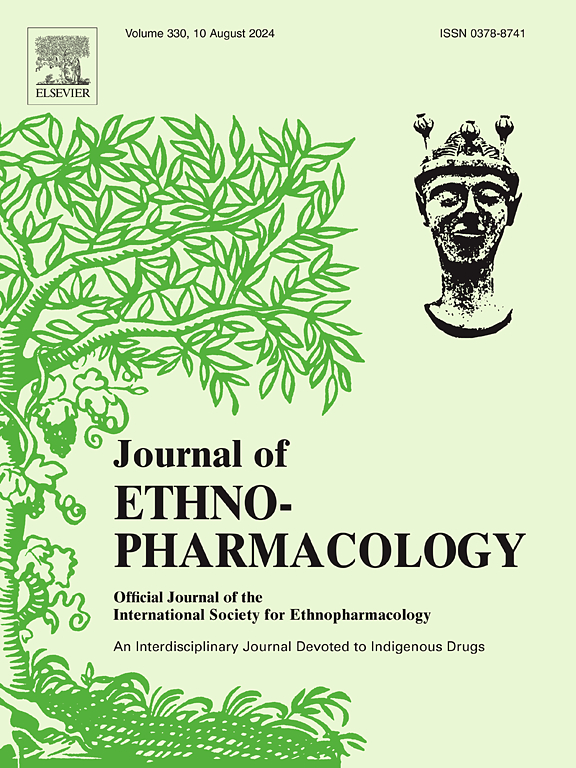补阳汤通过上调CXCR4抑制gpx4介导的铁下沉来减轻ovx诱导的肌少症。
IF 5.4
2区 医学
Q1 CHEMISTRY, MEDICINAL
引用次数: 0
摘要
民族药理学相关性:补阳汤(BYD)是一种传统的中药配方,已被证明具有增强肌肉和骨骼的潜力,但其在肌肉减少症(SP)中的作用尚不清楚。铁凋亡是一种由脂质过氧化引发的铁依赖性细胞死亡,在SP的发展中起着关键作用。目的:本研究探讨比亚迪是否通过CXCR4-GPX4信号轴调节铁凋亡来缓解SP。材料与方法:OVX模型SP体内模型,比亚迪不同浓度给药。通过行为测试、组织化学、qRT-PCR、TEM、MRI和micro-CT评估治疗效果。体外以Erastin为干预剂,采用WB、qRT-PCR、尼罗红染色、DAFH-DA染色、免疫荧光等技术。GEO数据库分析发现CXCR4为关键基因。在体内和体外遗传学上对CXCR4进行了抑制。结果:在体内,比亚迪增强了肌肉力量、分化和GPX4表达,同时降低了氧化应激。在体外,比亚迪促进肌肉卫星细胞(MuSCs)的增殖和分化,同时降低氧化应激和脂质过氧化。在体内和体外研究中,CXCR4的抑制导致了BYD治疗效果的丧失。结论:比亚迪通过CXCR4介导的GPX4上调抑制铁下垂,从而减轻SP,强调CXCR4是一个潜在的治疗靶点。本文章由计算机程序翻译,如有差异,请以英文原文为准。

Bu-Yang decoction attenuates OVX-induced sarcopenia by upregulating CXCR4 to suppress GPX4-mediated ferroptosis
Ethnopharmacological relevance
Buyang Decoction (BYD), a traditional Chinese medicine formula, has demonstrated potential in strengthening muscles and bones, but its role in sarcopenia (SP) remains unclear. Ferroptosis is an iron-dependent form of regulated cell death triggered by lipid peroxidation, which plays a key role in the development of SP.
Purpose
This study investigated whether BYD alleviates SP by modulating ferroptosis via the CXCR4-GPX4 signaling axis.
Materials and methods
OVX was used to model SP in vivo, with BYD administered at different concentrations. Therapeutic effects were assessed using behavioral tests, histochemistry, qRT-PCR, TEM, MRI, and micro-CT. In vitro, Erastin was used as an intervention, and techniques including WB, qRT-PCR, Nile red staining, DAFH-DA staining, and immunofluorescence were employed. GEO database analysis identified CXCR4 as a key gene. CXCR4 inhibition was performed pharmacologically in vivo and genetically in vitro.
Results
In vivo, BYD enhanced muscle strength, differentiation, and GPX4 expression while reducing oxidative stress. In vitro, BYD promoted MuSCs (Muscle Satellite Cells) proliferation and differentiation while lowering oxidative stress and lipid peroxidation. In both in vivo and in vitro studies, CXCR4 inhibition resulted in the loss of BYD's therapeutic effects.
Conclusion
BYD mitigates SP by inhibiting ferroptosis via CXCR4-mediated GPX4 upregulation, highlighting CXCR4 as a potential therapeutic target.
求助全文
通过发布文献求助,成功后即可免费获取论文全文。
去求助
来源期刊

Journal of ethnopharmacology
医学-全科医学与补充医学
CiteScore
10.30
自引率
5.60%
发文量
967
审稿时长
77 days
期刊介绍:
The Journal of Ethnopharmacology is dedicated to the exchange of information and understandings about people''s use of plants, fungi, animals, microorganisms and minerals and their biological and pharmacological effects based on the principles established through international conventions. Early people confronted with illness and disease, discovered a wealth of useful therapeutic agents in the plant and animal kingdoms. The empirical knowledge of these medicinal substances and their toxic potential was passed on by oral tradition and sometimes recorded in herbals and other texts on materia medica. Many valuable drugs of today (e.g., atropine, ephedrine, tubocurarine, digoxin, reserpine) came into use through the study of indigenous remedies. Chemists continue to use plant-derived drugs (e.g., morphine, taxol, physostigmine, quinidine, emetine) as prototypes in their attempts to develop more effective and less toxic medicinals.
 求助内容:
求助内容: 应助结果提醒方式:
应助结果提醒方式:


